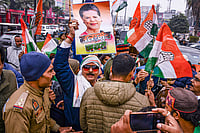In America, where I live, these are the dying days, and not just of the Trump administration. Take December 9th when 3,000 succumbed to COVID-19, but also to neglect, to fecklessness, to structural discrimination and misinformation and bad luck. More would follow. Or try December 10. While the virus ripped across the heartland, and through the cells nearby, Brandon Bernard was killed by lethal injection at the Federal Prison in Terre Haute Indiana. Barely 18 in 2004, he had participated in the murder of two youth ministers on the Fort Hood army base, but he had not pulled the trigger, nor had he been present throughout the crime. Even the prosecutor in his case had argued in the years following Bernard’s trial that he was not “the worst of the worst” and should be spared execution.
A day later, federal officials took the life of Alfred Bourgeois, who had brutally abused and eventually caused the death of his two-year-old daughter. Bourgeois had shown evidence throughout his life of difficulties in mental functioning, and his IQ hovered around the borderline of intellectual disability. He should at least be given a chance to establish in court that he met the test for disability, Supreme Court justice Sonia Sotomayor had argued. She did not prevail. These were deaths of state violence, judicially sanctioned and hurried through the killing floor by Donald Trump and Bill Barr ahead of Joe Biden’s inauguration.
ALSO READ: Our Wronged Rights
Before July, no federal prisoner had been executed in 17 years. You have to go back much further, to 1888, to see so many federal executions being carried during the lame duck period, when outgoing presidents generally defer to the possibility that a successor will see things differently.
Orlando Hall was the first federal death row prisoner to be killed after the election. Eight members of the execution team that carried out his lethal injection on November 19 appear to have contracted the coronavirus in the course of taking his life. The next to die will be Lisa Montgomery. 13 years ago, Montgomery fatally strangled Bobbie Jo Stinnett, who was 8 months pregnant, and cut the baby from her, attempting to pass it off as her own. As a child, Montgomery had suffered repeated rape by her stepfather, and members of her family have testified she was gang-raped in the course of being trafficked by her mother. A year before the murder she had sought counseling, but mental health services are scarce in rural Kansas. Her lawyers and experts say she was experiencing profound psychosis at the time of her crime. Montgomery is the only white person among six who will likely have been executed by the federal government in the last six weeks of Trump’s presidency. Corey Johnson, on January 14, and Dustin Hicks, on January 15, are next. The cadence of death is just about as high as the executioners can practically sustain.
ALSO READ: Nailed To The Cross, Ripe For Rescue
In my New York neighbourhood, people danced in the streets on November 7 when the Associated Press at last called the election for Biden. They poured onto streets still quieted by the pandemic and flags flew from cars and balconies, their symbolism reclaimed from the MAGA movement. Parties broke out on stoops and sidewalks. At Grand Army Plaza, the Civil War monument where months before Black Lives Matter protestors had congregated, a heaving crowd danced long into the warm evening. Soon enough, Trump would be gone, and with him the racism, the lies, the children in cages, the open corruption, if not from national life, at least from the Oval Office.

Not soon enough for Hall and Bernard and Bourgeois, likely not for Montgomery either, or Johnson or Hicks. There is a reason the death penalty is rare in democracies. A reason that goes deeper than the cost, the lack of deterrent effect, the well-documented inequity. The creation of a state machinery to deprive someone of their most basic human right—life— however finely calibrated or rarely deployed, places at the heart of a rights-based constitutional system a stark and impossible contradiction. At least 142 countries have abolished the death penalty either in law or in practice, as a result. Among those that continue the practice, China, Iran, and Saudi Arabia, are responsible for the vast majority of executions. In 2019, the US lead the very small league table of democracies, with 22 to Pakistan’s 14, Japan’s three and Bangladesh’s two. India managed four, the perpetrators of the Delhi gang rape were the first to be executed since Yakub Memon in 2015.
ALSO READ: In Our Roots Are Our Rights
A survey of global human rights trends in 2020 would barely mention the death penalty. It might remark on Iran’s hanging of the journalist Rouholla Zam for “crimes on earth”—a euphemism for dissent—in a survey of that country’s repressive climate, but it would likely focus on four things: the pandemic, both as an excuse for repression and an instance of governments failing in their responsibilities on healthcare, education, and livelihoods; ongoing democratic retrenchment lead (mostly) by elected strongmen among whom Trump is a relative lightweight, and the closing of what human rights technocrats call civic space; an accelerating climate crisis that is already driving conflict, migration and hunger, damaging health, and fueling hurricanes, wildfires and floods; conflict, persistent and resurgent.
If you were looking for data to add to your “worst year ever” list and to fill out these categories at the end of 2020, it would not be hard to find. According to the CIVICUS monitor, only 12.7 per cent of people around the world now live in countries rated in the top two tiers of openness, down sharply from 17.6 percent in 2019. The facts beneath the numbers are grim.
ALSO READ: Of Rage, Courage And Democracy
In China, Xi Jinping is building an AI-powered panopticon atop his already potent state security machinery, and decisively rolling back the opening that had taken place under his recent predecessors. The model is most clearly at work in Xinjiang, where predictive algorithms have guided officials as they send upwards of a million Uighur Muslims into a vast gulag of ‘re-education’ camps. Similar tools are in use across the country, woven deeply into the fabric of the Chinese internet and stitched into the surveillance network that blankets its public spaces. In Hong Kong, Xi has ended the one-country-two-systems model, gutting already-compromised institutions and arresting pro-democracy leaders. The image of newspaper-publisher Jimmy Lai in shackles sends exactly the message that was intended: no-one is safe.
Halfway across the world, nationalist governments in Hungary and Poland have seized control of the courts and the media, defying weak protestations from the European Union. Homophobia, attacks on women’s reproductive rights, and the demonisation of immigrants and refugees propagate from Budapest and Warsaw to right-wing parties across Europe. Meanwhile, the leaders of Brexitannia openly chafe at EU human rights rules, and insist on the sovereign right of the UK to depart without consequence from labour and environmental standards as it crashes out of the bloc.
ALSO READ: Mind The Gap
There is worse under way in East Africa, until recently the continent’s most hopeful region. Yoweri Museveni’s gerontocratic Ugandan regime is reacting brutally to the most sustained challenge it has faced in years. In Tanzania, journalists and opposition figures are being jailed in the wake of a rigged election, as they are ahead of one in Zambia, where efforts to rewrite the constitution in favour of President Edward Lungu are underway.

Neither regional nor global institutions have had much to say. Criticism of Tanzania’s election by US Secretary of State Mike Pompeo, against the backdrop of the Republican Party’s efforts to subvert the US result, provoked mainly laughter. US military support, aimed at fighting al-Shabab flows unimpeded to abusive security forces in Uganda and Kenya.
ALSO READ: Tiger, Tiger Whining Bright!
The toys they get, of course, are a fraction of the American weaponry going to the United Arab Emirates and Saudi Arabia, whence it rains down on Yemen and Libya. Joe Biden plans to nominate as his secretary of defence Lloyd Austin, a former general who has served on the board of Raytheon, maker of many of those munitions.
And if Egypt’s dictator Abdel Fateh al-Sisi has lost his biggest booster in Donald Trump, he can take comfort in France, where Emmanuel Macron draped the Grand Cross of the Legion of Honor across his breast at a ceremony kept hidden from the French media.
It is a list that could unfold, page upon page: via Brazil and Jair Bolsonaro’s assault on both human rights and the global climate, or the Philippines, Russia, the Sahel, Belarus, Iraq, Nicaragua. Or we could pause in Ethiopia, where Abiy Ahmed has gone from throwing open jails and winning Nobel prizes to a vicious war in Tigray. To say nothing of India, where Narendra Modi is building his Hindu rashtra, helped along by a compliant security establishment, a lapdog media, and a quiescent middle class.
ALSO READ: Silent Alarm
It is tempting, as we make this list at the exhausted end of 12 terrible months, to chalk it all up to the awfulness of this “worst year ever”, as if it might be contained between two neat parentheses, a hitch in the steady progress of the late 20th century and early aughts, to treat the pandemic deaths, the climate deaths, the bombs and beheadings and celebrity accidents as a bit of cosmic misfortune. The more rational approach might extend period under analysis a little to encompass the global turn to demagogy and authoritarianism, back to 2014, when Modi came to power perhaps, or 2016 when Trump did, and thence back to 2008, when the financial crisis helped to prepare the ground for their ascent.
Technological determinists might suggest we go back to 2004, when Facebook was founded, but 2001 is more plausible. It was then that the wars in Iraq and Afghanistan permanently damaged the prestige and effectiveness of the United Nations and western-led “democracy promotion”.
Maybe it really began with Ronald Regan, or with the assassination of Salvador Allende, or at the birth of liberal international order secured and dominated by the United States.
ALSO READ: From The Ballad Of Indian Gaols
In March of 1964 both Martin Luther King and Malcolm X attended the senate debate on the Civil Rights Act, the legislation that would outlaw race-based discrimination and create a foundation for the Voting Rights Act a year later. Civil rights legislation was a kind of second reformation for a US system that had officially recognised the full humanity of Black people in the constitutional amendments that followed the Civil War, but left much of the architecture of official racism in place.
For X it would be far from enough. The next month he would leave for the Haj, and for an extended tour of Africa, where he would try to mobilise leaders, individually and through the OAU, behind his crucial insight: anti-Black racism, and the vast machinery of law and practice on which it continued to rest it could not be solved in the domestic register of civil rights. It was a human rights issue that the global community ought to address through the UN. The Dead Are Arising, a new biography by journalist Les Payne and his daughter Tamara documents that journey, shuttle diplomacy to build a human rights coalition among newly-liberated states. The mission failed. Freedom was new, and the US powerful. African states were not ready to speak out. Within a year Malcolm X would be assassinated, possibly with the connivance, or the tacit consent, of the FBI. He would have recognised all too clearly what happened this year.
ALSO READ: Pray, Speak The Truth, Milords!
While my neighbours danced in Brooklyn, bands of Trump supporters, many of them armed, gathered outside vote-counting centers. And the President’s lawyers began what would be a futile barrage of legal challenges aimed at overturning the result. Everywhere, their tactic would be much the same: to zero in on places with a significant black electorate—Detroit, Philadelphia, Atlanta—and argue for the exclusion of votes. Only a return to Jim Crow America would hand a second term to Trump, and the Republican party was looking to get back there as fast as possible. Since they could marshal no evidence, and make no progress in court, they would flood the internet and right-wing television with conspiracy theories and false claims of fraud, undermining the legitimacy of the outcome, and laying the political ground for fresh voter-suppression efforts in the years to come. Joe Biden had pulled off the increasingly difficult feat of winning the Presidency with Black support despite an electoral college designed to privilege white votes. His Presidency will likely be hampered by a senate similarly designed to cement white control, a senate where the current Republican majority represents 40 million fewer voters than the Democratic minority. And the Supreme Court has long since gutted the voting rights act, pulling its sharpest teeth in a 2013 judgment. It is unlikely to prevent fresh moves to curtail voting in Republican-controlled state legislatures.

This is the second great contradiction at the heart of US democracy. It is a two-party system, in which one party can only get and hold power by anti-democratic means. That asymmetry cannot be resolved by a return to “normality”. On the contrary, it is built into the institutional foundations of normality. Moreover, it is entwined with the torsions that state sanctioned killing, the killing of George Floyd and Breonna Taylor, and the executions at Terre Haute, lay bare. Reform pasted over the top of this cleavage, is, as Ambedkar might have said, top-dressing over undemocratic soil.
ALSO READ: In Search Of Sadda Haq
The marchers for Black Lives Matter this summer were not asking for reform. Their demand was and is for full citizenship, for human rights. But reform is tempting for people of good will who wield awesome power, who find themselves pinioned by its exigencies. Listen to Barack Obama, speaking to the television host Stephen Colbert to promote the first volume of his autobiography. Gently pressed on his embrace of drone strikes Obama answered: “The problem with the drone program was not that it caused an inordinate amount of civilian casualties. The drones probably had less collateral damage than if you send in troops … or if you are dropping ordnance ... The problem is that it starts giving you the illusion that it is not war … the machinery of it started becoming too easy. I actually had to impose internally a substantial set of reforms in the process to step back and remind everyone involved this isn’t target practice; each time we make this decision we are engaged in the most profound act any government can make, which is using lethal force, and there need to be better checks and balances.”
Obama walks to the brink of insight here: something about killing by joystick is different, even wrong. But the answer is not to stop or to reconsider fundamentally the Authorisation for the Use of Military Force granted in the wake of the 9/11 attacks. It is slightly better rules. Among those rules, introduced in May 2013, was a requirement of “near certainty” that no civilian would be harmed, that the target could not have been arrested, and that they represented “a continuing and imminent threat”. None of those rules got in the way of the Hellfire missiles that hit a Yemeni wedding party later that same year, killing 12. That is only the most celebrated case, hundreds more died in the years that followed, near-certainty notwithstanding.
ALSO READ: Camus In Kashmir
Why are these peculiarly American dynamics worth dwelling on, as India jails elderly dissidents and intervenes to prevent loving couples from being married, where the very citizenship of crores of Muslims is thrown into question and the Supreme Court nods in time? What do they matter to Polish women marching for abortion rights, or Belarussians demanding an end to the rule Alexander Lukashenko? Do they speak at all to a Palestinian, cut off from his olive orchard by Israeli wire, or an Indigenous Brazilian, staring down the barrel of a rancher’s gun?
The obvious answer is that for all its hypocrisies, the US looks like freedom to many, that its example still matters. Or that a normal US is capable of joining with other democracies to limit the worst abuses and constrain democratic backsliding. There isn’t much evidence for either of these propositions, although it is true that an explicitly anti-democratic United States, of the kind represented by the Trump administration, means worse outcomes for everyone.
No. The example of the US matters because it reminds us that constitutions, and institutions, domestic and international laws, while crucial can achieve only so much. The demand for human rights, in the hard years to come, will live in the streets. It will face lathis and teargas, troll armies and armed troops, but like Malcolm X, and like Ambedkar, people everywhere now understand that what needs to change is not only unjust laws, but the distribution of power, and they will work to take it back.
(Views are personal.)
Nic Dawes is a writer and commentator. He is the former Deputy Executive Director of Human Rights Watch and was previously Chief Content and Editorial Officer of Hindustan Times.





















